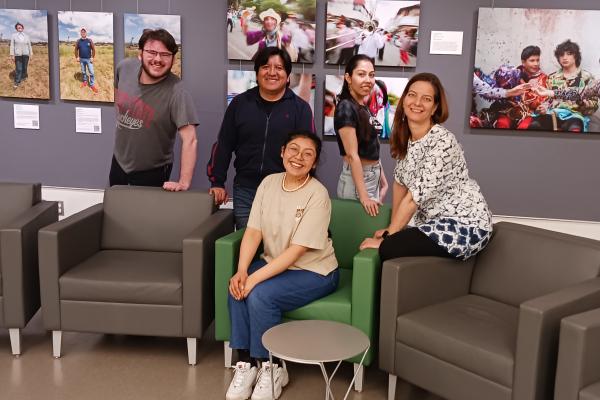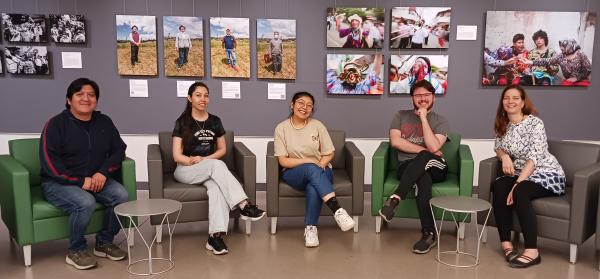Congratulations To Our Spring 2023 Whitten Scholarship Awardees!

Each semester the exceptional work and research that student curators undertake with the Kawsay Ukhunchay: Andean & Amazonian Indigenous Art & Cultural Artifacts Research Collection is recognized through the awarding of the Whitten Andean & Amazonian Studies Scholarship.

This semester's awardees, who work under the guidance of Faculty Curator and Professor Michelle Wibbelsman, are (left to right):
- Victor Vimos (PhD Student in Latin American Cultural & Literary Studies)
- Shima Karimi (PhD Student in Latin American Cultural & Literary Studies)
- Anais Fernandez (Majors: Political Science and Spanish)
- Cameron Logar (Major: Biochemistry)
- Tamryn McDermott (PhD Student in Arts Admin., Education, & Policy)
Learn more about these dedicated kawsay waqaychaqkuna (those who safeguard, keep and preserve with cariño and care) here.
Wibbelsman and the curators engage in a unique combination of research, teaching, and outreach. Much of their work in Spring 2023 was centered on the Dancing with Devils: Latin American Masks Traditions exhibition in the Barnett Center Collaboratory, which has just come to a close after a full academic year as a campus hub for interdisciplinary academic and outreach programming.
In addition to activities directly connected to the Dancing with Devils exhibition, each curator has actively pursued individual projects that relate to the Collection.
As Tamryn McDermott prepares for her final year of dissertation work, her development of an AirTable database for the Collection has informed her research in Art Education in significant ways:
I consistently find myself integrating ideas from my experiences with the Collection. [...] It is exciting to me to have had time over the past two years to explore and work with the collection in ways that are now informing decisions about my own dissertation project.
Tamryn has also worked with Wibbelsman this semester to develop exchange partnerships with Denison University. She looks forward to seeing how curators and educational programming designers at Denison will display and contextualize objects from the Collection in new ways.
Anais Fernandez's projects this semester have included transcribing an interview about quipus, presenting at a pedagogical conference alongside Wibbelsman, and preparing the resulting paper for publication. Her work with the Collection has been a natural complement to her Peruvian heritage and love of Peruvian dance and festival clothing:
I have a strong and deep connection and interest in Latin American cultures, specifically Andean and Amazonian. [...] I've found a space and support within my university to continue researching the topics I want to explore.
Cameron Logar has been busy researching the diablada festival in which the devil masks are used. This research has required him to consider in depth the responsibility of learning about the history, meaning, cultural context, and representation of Collection objects. This work has been personally rewarding for Cameron:
I am thankful that I've had the good fortune to enjoy this wonderful opportunity. I can truly say that it has changed my life for the better, giving me new direction, new goals, and a new passion.
Cameron was also one of only five undergraduate students selected for the GAHDT Society of Fellows Undergraduate Apprentices on this year's theme of "Archival Imaginations" for his project "The Details in the Devils: Plural Meanings in Diablada Performance and Archival Presentation."
Shima Karimi has conducted comparative research that explores the role of Indigenous women in the mythology and cultural narratives of Iran and the Andes. She seeks to challenge the exclusion of Indigenous women from mainstream historical and cultural narratives by highlighting their contributions to the cultural heritage of their communities. This work has helped her to better understand the intersection of gender, culture, and mythology and enhanced her scholarly abilities:
Working with the Collection has allowed me to develop my research skills and deepen my understanding of the complexities of indigenous cultures and communities.
Victor Vimos, who describes the Collection as "a space for learning and individual and collective growth," has also grown as a scholar through the writing of his master's thesis on an Andean poet and Quechua and Aymara worldviews:
Since I started my work [with the Collection], my relationship with Andean concepts has been broader and I have been able to carry out research in dialogue with them.
Please join us in congratulating our spring 2023 student curators and thanking them for their many contributions to Andean and Amazonian studies at OSU!
The Andean and Amazonian Indigenous Art and Cultural Artifacts Research Collection is permanently housed in the Department of Spanish and Portuguese in Hagerty Hall 255 and supported by the Department of Spanish and Portuguese, the Center for Latin American Studies (in part through Title VI funding from the US Department of Education), and generous private donations from Dr. Norman Whitten. To learn more about the collection please visit the AAAC website and the K'acha Willaykuna main website.
